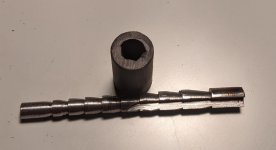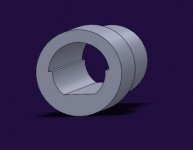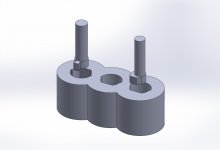BoxcarPete
Stainless
- Joined
- Nov 30, 2018
- Location
- Michigan, USA
I have a project which requires making two bushings out of acetal plastic that have an odd internal profile cut into them. My first thought was to make a broach from 4140 prehard and jam it through, but the resulting hole was sloppy and the profile changed size through the process. The middle diameter is smaller at the end than the beginning, pushing the mating part against the larger diameter and leaving a gap on the flat, before completely jamming up halfway through the bushing. One of the shoulders is also poorly formed, not in line with the other side and the center.
The profile is a flat .100 from center meeting a diameter .250, and a semi-circle of .285 cut out of the half opposite the flat. Pilot hole is .200 with the flat cut tangent on the broach. Profile length is .750, but it is technically blind so I made it the full .850 and plan to press fit a slug into the back to make the shoulder.
I'm wondering if I might get a better result trying to make two separate broaches, one to make the .250 diameter with the flat on the bottom, and then using that as a pilot shape on a completely separate broach to carve out the semi-circle.
Here's a picture of my first attempt, and a screenshot of the part I want (pressed slug will be going in from the side shown). Ideally, I want to get ±0.002 on the diameters, but my first attempt is pretty discouraging for that accuracy. Semi-circle shoulders can float a bit (maybe ±.010), but having accurate diameters is pretty important.
Any suggestions on making multiple parts and fitting them together should come with the caveat that it needs to be fluid tight from inside to outside.


The profile is a flat .100 from center meeting a diameter .250, and a semi-circle of .285 cut out of the half opposite the flat. Pilot hole is .200 with the flat cut tangent on the broach. Profile length is .750, but it is technically blind so I made it the full .850 and plan to press fit a slug into the back to make the shoulder.
I'm wondering if I might get a better result trying to make two separate broaches, one to make the .250 diameter with the flat on the bottom, and then using that as a pilot shape on a completely separate broach to carve out the semi-circle.
Here's a picture of my first attempt, and a screenshot of the part I want (pressed slug will be going in from the side shown). Ideally, I want to get ±0.002 on the diameters, but my first attempt is pretty discouraging for that accuracy. Semi-circle shoulders can float a bit (maybe ±.010), but having accurate diameters is pretty important.
Any suggestions on making multiple parts and fitting them together should come with the caveat that it needs to be fluid tight from inside to outside.




